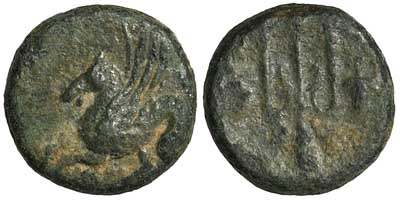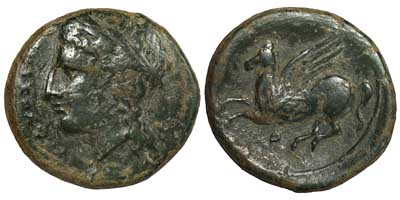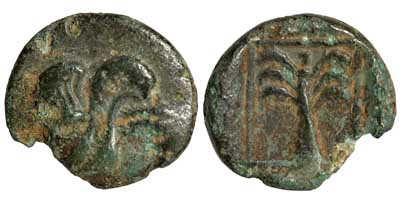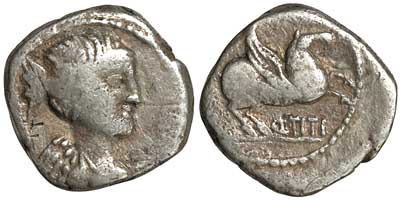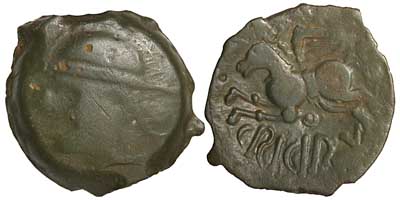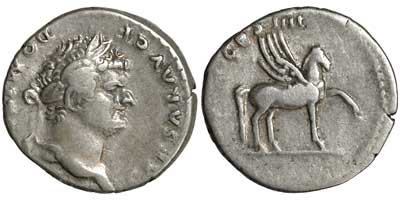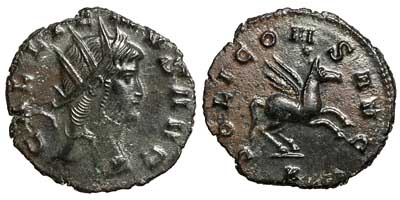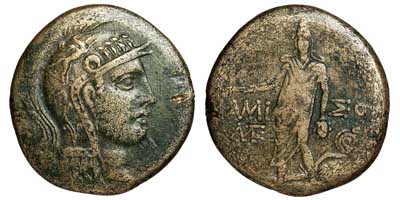| Home Page | Site Map | Useful Links | Email Me | Glossary | Next Page |
| ---------- Interesting Things About Ancient Coins ---------- |
| The Winged Horse Pegasus on Ancient Coins |
Pegasus, or Pegasos as he was called by the Greeks, was a winged horse, born from the liaison of the sea-god Poseidon and the beautiful Medusa. The liaison made the goddess Athena angry, and she cursed Medusa to be ugly and deadly. When she was killed, Pegasus sprang from her neck. (See my page on the story of Medusa).
It's easy to speculate on the origin of the idea of a winged horse. A horse that seems as swift as the wind .. an exceptional horse .. might seem to fly, and might be talked about as flying. And the flight of Pegasus can be used as a metaphor for the soul's immortality.
In legend, Bellerophon, who became king of Corinth, tamed Pegasus with the aid of a golden bridle given to him by the goddess Athena. So Pegasus appears on many coins of Corinth and her colonies. He appears on other ancient coins too. Here are some of them.
Corinth
In classical times, Corinth was a rich and quite powerful city and seaport on the narrow isthmus that joins the Peloponnesos with the rest of Greece. Like most Hellenic city-states, Corinth produced its own distinctive coins.
This little bronze is one of my earliest Pegasus coins. It has a lively representation of Pegasus, with Poseidon's trident on the reverse. You can just see the top of the letter koppa under the forelegs, looking like an "o" because you can't see the long tail. That was the Greek initial letter of the name of the city. You can see the koppa better on the next coin.
You can see another of these coins on my holed coins page.
This (right) must be my most beautiful coin. Athena is shown on the obverse, wearing the type of helmet typical of the city, tilted back over a leather cap. On the reverse is Pegasus, his wings sweeping upwards. They look as though they belong to him, and are not just stuck onto a horse. The letter koppa is complete and clear on this coin.
The next two, smaller, coins are also very pleasant. The female head on both of these is probably Aphrodite.
On the left, she is wearing a sakkos, which is basically a bag bound with string. That looks a lot nicer than it sounds. Someone has has two tries at making a hole through this coin, probably to make it into a pendant of some sort, but has given up both times. Though, it is possible that these were test holes, dug to see if the coin was pure silver. (It is.)
On the right, on a smaller coin still, Aphrodite has a series of braids, pulled back and tied behind her head.
My last two Corinthian coins come from the town's next age. The town was completely destroyed by the Romans in 146 BCE, the same year as their destruction of Carthage. It was only successfuly repopulated a century later, in 44 BCE, when it was rebuilt as a Roman city under Julius Caesar.
 A semi-autonomous brass AE22 from Corinth, 34-31 BCE. It is 21mm by 22mm across, and weighs 6.2 grammes.
A semi-autonomous brass AE22 from Corinth, 34-31 BCE. It is 21mm by 22mm across, and weighs 6.2 grammes.
Around the time of the rebuilding, there were several coins dealing with the myth of Bellerophon and Pegasos and their battle with the monstrous Chimaera, a creature with a lion's head in front, a goat's head rising from the middle of its back, and a snake (complete with head) for a tail.
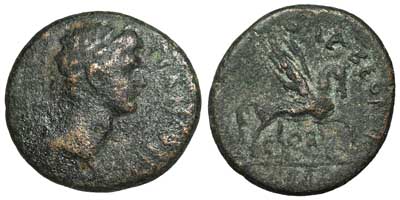 A bronze AE21 of Tiberius, from Corinth, 14-37 CE. It is 19mm by 21mm across, and weighs 6.3 grammes.
A bronze AE21 of Tiberius, from Corinth, 14-37 CE. It is 19mm by 21mm across, and weighs 6.3 grammes.
The Chimaera breathed fire, and was a grave danger to the people of Corinth. Bellerophon, aided by the goddess Athena, was able to tame Pegasos and ride him into battle against the monster. This coin shows the battle, with Pegasos striking down the monster and Bellerophon on his back about to cast a spear.
Bellerophon and Chimaera are also shown on a coin of Leukas further down this page, but unlike this battle scene, they are on different sides of the coin.
The final Corinthian coin was minted under Tiberius, and shows his bust on the obverse. Pegasus is raising one foreleg to the right, wings held high.
Syracuse and Sicily
Syracuse was founded from Corinth in around 734 BCE, and became an inpoortant and powerful city-state in its own right. It is situated on the southern coast of Sicily, in a position to dominate the local traffic on the Mediterranean.
Many coins from Syracuse also used Pegasus as a theme. The small bronze on the right dates from the time of Timoleon, a Corinthian statesman who rescued Syracuse from the reign of a tyrant.
The obverse has the head of Apollo apparently wearing a tainia, and on the reverse is Pegasus flying to the left.
To the left is a very similar coin, but with a more beautiful Apollo and without the legend or the symbol on the reverse. Apollo has a laurel wreath, which is more usual for him as the laurel was his sacred plant.
On the right is a third bronze coin fryom Syracuse, this one much heavier and therefore representing a different denomination. This coin shows Persephone, her head wreathed in grain, instead of Apollo. Pegasus is flying to the right.
On the left is a small silver coin from the same period. This one shows Arethusa or Artemis or a combination of both, with three dolphins swinning around her head. On the reverse is the forepart of Pegasus with a curled wing, with a slightly archaic influence, looking older than the coin actually is.Artemis-Arethusa is wearing a type of headband which can be seen in more detail on the next coin.
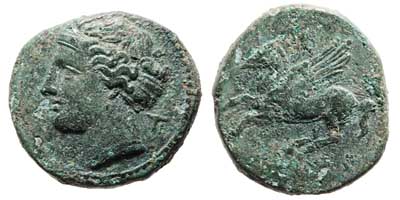 A bronze coin from Syracuse, reign of Hieron II, 271-215 BCE. It is 17mm across and weighs 3.12 grammes.
A bronze coin from Syracuse, reign of Hieron II, 271-215 BCE. It is 17mm across and weighs 3.12 grammes.
The coin on the right is a small bronze which has a low-contrast earthy green patina and quite a shallow relief, making it difficult to photograph effectively. But there is a pleasant bust there once those technical problems were solved, with the head of Artemis-Arethusa wearing a combination of headbands, an ampyx and sphendone.
There is just enough of the legend visible underneath Pegasos to see that it must have read IEPΩNOΣ, dating the coin to the reign of Hieron II.
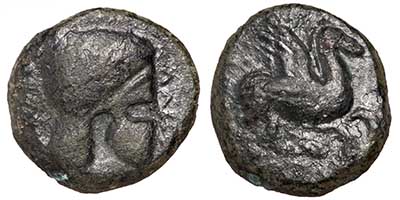 A bronze AE18 of the town of Entella in Sicily, before 404 BCE. It is 18mm across and weighs 5.15 grammes.
A bronze AE18 of the town of Entella in Sicily, before 404 BCE. It is 18mm across and weighs 5.15 grammes.
The Carthaginians fought in Sicily for many years, trying to establish a foothold and take over. It seems that they had some Campanian mercenaries, with whom the town of Entella was on friendly terms. So this coin shows a Campanian helmet on one side, with the name of the town, as well as Pegasos on the reverse.
We know this coin was produced before 404 BCE because Diodoros, a Greek historian, tells is that it was in that year that the mercenaries killed all the male inhabitants and took over the town — a lesson in the trustworthiness of mercenaries.
Diodoros was writing about 350 years after the event, so as always in such cases he should be read with some caution.
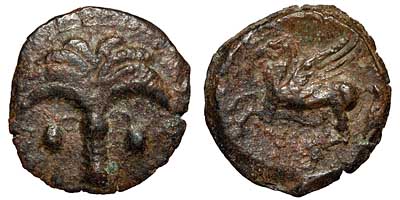 A bronze AE15 of the Carthaginians in Sicily, 3rd Century BCE. It is 15mm across and weighs 2.2 grammes.
A bronze AE15 of the Carthaginians in Sicily, 3rd Century BCE. It is 15mm across and weighs 2.2 grammes.
When the Carthaginians had established a presence on the island, they produced some of their own coins, even while they and their allies were still fighting, in Syracuse and other places. Coins like this are referred to as "Siculo-Punic."
The palm tree, called Phoenix, is probably a reference to the Phoenician origins of Carthage, where the tree is common.
 A bronze AE14 from Kephaloidion in Sicily, 334-336 BCE. It is 13 x 14mm across and weighs 2.2 grammes.
A bronze AE14 from Kephaloidion in Sicily, 334-336 BCE. It is 13 x 14mm across and weighs 2.2 grammes.
This small and rather scarce coin is from another Sicilian city, Kephaloidion, in the middle of the north coast. The obverse shows the head of Herakles, in his traditional lion-skin headdress. Pegasos is flying to the right on the reverse.
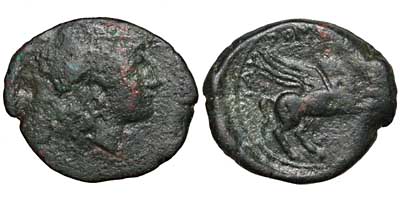 A bronze AE20 from Tauromenion in Sicily, 275-212 BCE. It is 20 x 18mm across and weighs 4.5 grammes.
A bronze AE20 from Tauromenion in Sicily, 275-212 BCE. It is 20 x 18mm across and weighs 4.5 grammes.
This last Sicilian coin on the left is from Tauromenion (modern Taormina), on the eastern coast, with a view of Mount Aitna, modern Etna.
It follows the same style as the silver coins of Corinth, with the head of Athena on the obverse wearing a Corinthian helmet. On the reverse, Pegasus is flying to the right.
Anatolia
Several towns from the region known as Anatolia, which comprises most of modern Turkey, produced Pegasus coins.
The two coins below are from Skepsis. The first tiny bronze shows the forepart of Pegasus with wings curled downwards. On this example, it's not easy to make out what's what. Pegasus is supposed to be flying to the left, but I think he is flying right; you can see one wing and another object, about which, more below.
The reverse shows a fir tree inside a square – not a palm tree like the Siculo-Punic coin above.
The second Skepsis coin is larger and heavier. It has a startling addition to Pegasus – it looks like a fluted column, but it is actually a drinking horn. Such an ornate horn, decorated with a model of the forepart of Pegasus, was known as a pegasosrhyton.
Several detailed examples in gold are known. Some of them could not be put down until they were empty, which made them quite impractical as tableware, and they were clearly designed to encourage copious messy drinking.
Having seen this, if you look back at the smaller coin, it is clearly the same image in reverse; the object at top left is not a second wing, as I thought when I first saw it, but the drinking funnel of the pegasosrhyton.
The reverse of the larger coin has SK for Skepsis in Greek letters.
 A bronze AE12 from Adramytteion in Mysia, 4th century BCE. It is 12mm across and weighs 1.70 grammes.
A bronze AE12 from Adramytteion in Mysia, 4th century BCE. It is 12mm across and weighs 1.70 grammes.
The next coin, above on the left, shows the fore-part of Pegasus, with his wing-tips pointing forward, this time flying to the right. This reminds me of photos or slow-motion clips of large birds in flight, where you can see that the pressure of the air during the downward stroke of their wings splays out the feathers at the tip, quite like this "curled wing" representation, which you can also see clearly on the second Skepsis coin and also elsewhere on this page. Of course, the Greeks would not have had access to anything like that, but nevertheless, perhaps the curved appearance shows Pegasus using his powerful wings in flight.
On the obverse of this coin of Adramytteion is the head of Zeus, which also appears on the smaller coin of Iolla to the right, also from Mysia. This coin, too, has the forepart of Pegasos with curled wings.
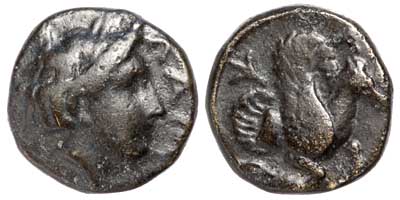 A bronze AE10 from Lampsakos in Mysia, 4th-3rd century BCE. It is 10mm across and weighs 1.40 grammes.
A bronze AE10 from Lampsakos in Mysia, 4th-3rd century BCE. It is 10mm across and weighs 1.40 grammes.
 A bronze AE22 from Lampsakos in Mysia, 2nd-1st century BCE. It is 22mm across and weighs 8.7 grammes.
A bronze AE22 from Lampsakos in Mysia, 2nd-1st century BCE. It is 22mm across and weighs 8.7 grammes.
The two coins above are from Lampsakos. The tiny bronze coin on the left is only a centimetre across, but still manages to have a detailed female head on one side and the forepart of Pegasos on the other. Once again, the forepart is cut off.
To its right is a larger coin, this time with the head of Priapos on the obverse, but with the same forepart of Pegasos on the reverse.
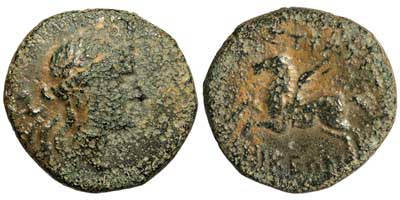 A bronze AE15 from Stratonikea in Caria, 2nd-1st century BCE. It is 15mm across and weighs 3.1 grammes.
A bronze AE15 from Stratonikea in Caria, 2nd-1st century BCE. It is 15mm across and weighs 3.1 grammes.
On the right, another nice Pegasus, though the coin is very pitted and has an odd yellowish patina. It is from Caria, a region along the coast of Anatolia. This coin is shown in more detail on my colourful patinas page.
To the left is another coin from Caria, though I haven't been able to find out exactly which town. It's smaller than the previous coin, and the lack of any (visible) legend does not help.
But there is enough detail to see an eagle with spread wings on the obverse, and Pegasus springing or flying to the right on the reverse.
On the right is a third coin from Caria, this time from near the island of Cos. Pegasus was clearly a popular coin image in this area, but this time there is a specific link with the place.
It was said that Bargylia was founded by Bellerophon in honour of his companion Bargylos, who had been killed by a kick from Pegasos.
The reverse shows a local cult image of Artemis Kindyas, on whom is was said that rain never fell. Several images of Artemis appear on my page on Diana the Huntress.
Next is another coin from Bargylia, a sweet little thing with the forepart or protome of Pegasos on the obverse.The reverse shows the protome of a stag. The forelegs of both Pegasos and the stag are in a leaping-forward position.
Beneath the stag are the Greek letters BAP, the first letters of the name of the town.
This is a tiny silver coin, darkly toned. It is my earliest Pegasos coin, dating from the first half of the 5th century BCE. It is quite worn, and although the goat on the reverse is clear enough, you have to know what you are looking for to make out the forepart of Pegasos on the obverse, head to the right, his wing curling upwards and forwards.
You can see a similar representation, much clearer, on the coin of Pantikapaion a little way down the page.
This little coin on the left was sold as from Alabanda in Caria, but it has not proved easy to confirm this. It is certainly the right sort of style and is clearly quite old. The obverse is not easy to make out, but looks like a male head facing left. But the Pegasos on the reverse is quite clear.
Next, a very nice bronze coin from Amisos in Pontos. Amisos produced many coins with images relating to the legend of Medusa. On the obverse of this coin is Perseus, the hero who slew Medusa. On the reverse, Pegasus, standing drinking. The name of the town is below.
It was while Pegasus was drinking at the well of Pirene that Bellerophon was able to throw Athena's golden bridle over his head and ride him – leading to the defeat of the monstrous Chimaera pictured on the coin of Leukas, elsewhere on this page. So this coin probably refers to that part of the myth.
The next coin, on the left, is a little and lightweight silver obol from the coastal town of Kelenderis in Silicia, now Aydincik in Turkey. You can see how the style of this coin differs from the more modern coins around it. It shows only the forepart of Pegasos.
The last coin in this section, below, is a rather rough bronze from Tripolis in Lydia. It's a pity this coin lacks detail, because it has an unusual reverse.
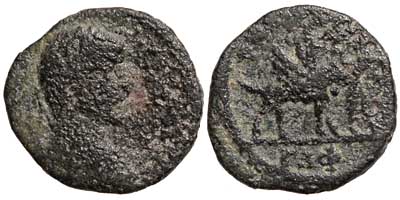 A bronze coin of Elagabalus from Tripolis in Lydia, 221-222 CE. It is 19mm across and weighs 3.05 grammes.
A bronze coin of Elagabalus from Tripolis in Lydia, 221-222 CE. It is 19mm across and weighs 3.05 grammes.
Pegasos is being ridden by a satyr who is playing a double flute, and is being led by a Bacchic figure.
The Greek lettering at the bottom, ΓΛΦ, actually forms a date, year 533 in the Seleucid dating system, which corresponds to 221-222 BCE in our terms; the end of the reign of the emperor Elagabalus, whose bust appears on the obverse.
 A bronze dichalkion from Pantikapaion in Thrace, 314-310 BCE. It is 14mm across and weighs 2.88 grammes.
A bronze dichalkion from Pantikapaion in Thrace, 314-310 BCE. It is 14mm across and weighs 2.88 grammes.
Thrace
Next, an interesting coin, on which Pegasus's wings are again curled forwards.
It is from Pantkapaion, and has the letters PAN on the reverse. This has led people to believe that the image on the obverse is the god Pan, which would make a nice visual pun of the sort that occurs on other Greek coins (such as a rose on coins from Rhodos, and a goat on coins from Aigeai; both place names sound a lot like the name of the object illustrated).
But there is evidence that this is just a generic satyr, not Pan at all, which I think is a pity.
On this coin, again, only the front half of Pegasus is shown, sharply cut off rather than running off the edge of the coin. There are no coins showing only the back half. I wonder why?
 A bronze AE22 from Lokroi Epizephyrioi in Bruttium, 300-280 BCE. It is 22 x 19mm across, and weighs 10.2 grammes.
A bronze AE22 from Lokroi Epizephyrioi in Bruttium, 300-280 BCE. It is 22 x 19mm across, and weighs 10.2 grammes.
Italy
Lokroi Epizephyrioi, modern Locri in Calabria, named itself "Above the west wind," having moved from the original settlement site where it was too windy.
This coin shows the head of Athena on the obverse, much like the silver stater of Corinth at the top of the page. On the reverse is a detailed representation of Pegasus.
Like a few of these coins, the artist seems not to have been quite sure how to handle the legs, which here are rather long and spindly.
Greece
Next is a nice little coin carrying a heavy weight of Greek legend. Pegasus is being ridden by Bellerophon, who has tamed him with the aid of a golden bridle given by Athena. Bellerophon then fought and killed Chimaera, a monster with the head of a lion, the tail of a serpent, and a goat's head emerging from its back (according to Homer). This creature is shown on the reverse of the coin.
 A Silver hemidrachm from Leukas in Arkanania, 380-320 BCE. It is 11 x 12mm across and weighs 1.05 grammes.
A Silver hemidrachm from Leukas in Arkanania, 380-320 BCE. It is 11 x 12mm across and weighs 1.05 grammes.
There is a coin from Corinth near the top of this page that shows the actual battle. Chimaera and many other monstrous creatures are shown on my "Monsters on Ancient Coins" page.
On the left is a small silver coin which is also from Leukas. This one just has the forepart of Pegasos, and it is likely that it is there because Leukas was colonised from Corinth.
 A silver hemiobol from Leukas in Akarnania, 3rd century BCE. It is 8mm across and weighs 0.21 grammes.
A silver hemiobol from Leukas in Akarnania, 3rd century BCE. It is 8mm across and weighs 0.21 grammes.
Corinth and its colonies used Pegasos on their coins as a badge of recognition, and there are several examples at the very top of this page.
A third coin from Leukas. This one is tiny and I know little about it that cannot be seen here. There is a possible connection between the trident and Pegasos. The Trident is Poseidon's symbol. He was a horse god as well as a sea god, and was said to have fathered Pegasos on the gorgon Medusa.
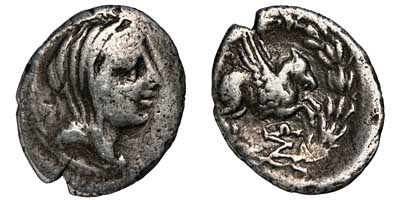 A silver octobol from Korkyra, now Corfu, after 229 BCE. It is 15 x 19mm across and weighs 2.79 grammes.
A silver octobol from Korkyra, now Corfu, after 229 BCE. It is 15 x 19mm across and weighs 2.79 grammes.
It is possible that the island of Corfu, then called Korkyra, also provided colonists for Leukas. The silver coin on the left is from Korkyra. At the time this coin was struck, the island was a Roman protectorate.
The obverse shows the veiled head of Dione, mother of Aphrodite. The reverse has a lively Pegasos with a Sigma-Omega monogram below it, within an olive wreath.
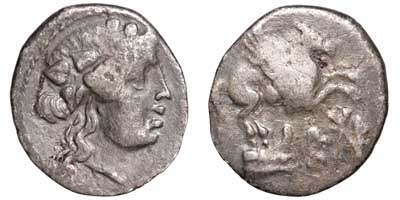 A silver didrachm from Korkyra, now Corfu, after 229 BCE. It is 19 x 21mm across and weighs 4.18 grammes.
A silver didrachm from Korkyra, now Corfu, after 229 BCE. It is 19 x 21mm across and weighs 4.18 grammes.
There is another coin from Korkyra, in the same period, on the right. This one has the head of Dionysos on the obverse, wreathed with ivy, his sacred plant.
 A bronze AE20 from Thessalonica in Macedonia, 187-131 BCE. It is 20 x 18mm across and weighs 10.5 grammes.
A bronze AE20 from Thessalonica in Macedonia, 187-131 BCE. It is 20 x 18mm across and weighs 10.5 grammes.
Pegasos, on the reverse, is leaping from the prow of a vessel, depicted in small scale as was often done in order to show symbolically something that otherwise would not fit on a coin.
It would not be right to think of this as the invention of the aircraft carrier.
On the coin above, from ancient Macedonia, Pegasus is rearing on his hind legs, spreading his wings, perhaps to take off. This is a quite "naturalistic" portrayal. This coin shows the wreathed head of Dionysos on the obverse.
Ambrakia, an important town in Epeiros, was originally a colony of Corinth, and like its other colonies, used the same basic coin type as the parent city.
 A silver drachm from Herakleia in Akarnania, 330-280 BCE. It is 14 x 15mm across and weighs 1.49 grammes.
A silver drachm from Herakleia in Akarnania, 330-280 BCE. It is 14 x 15mm across and weighs 1.49 grammes.
The silver stater above has the head of Athena on the obverse, and Pegasus on the reverse. There is a large A behind Athena's head to distinguish this as being from Ambrakia rather than Corinth, on whose coins you might find the letter Q.
This coin also has a control symbol, a rather elongated volute krater, filling any remaining space behind Athena's head.
 A silver third stater from Metapontion, perhaps c. 4th century BCE. It is 16mm across and weighs 2.7 grammes.
A silver third stater from Metapontion, perhaps c. 4th century BCE. It is 16mm across and weighs 2.7 grammes.
The reverse of the silver drachm above shows the goddess Hera, wearing a stephane and carrying a sceptre. Hera appears on fewer coins than one might think given that she was the chief female deity of the Greek pantheon. Her appearance on this coin is explained by the name of the town, Herakleia, which means "Glory of Hera."
Pegasos' tail is tied at the base, a sign of domestication that appears on many coins. I wonder whether this is intended, or just the way horses were shown? He is in a posture which could be interpreted as leaping or flying, which again is common on these coins.
The archaic-looking coin on the right is from Metapontion in Luciana. I have not been able to determine an accurate attribution and date, but the city is definite; the grain motif is typical, and the legend META on the reverse confirms it.
It does not resemble a typical 5th century BCE archaic Metapontion coin, however; those had an incuse grain ear on the reverse. Perhaps it is more recent.
The stance of the Pegasos is a little unusual; walking, with a curled wing. The hooves look rather odd, and there are things on his breast which might be feathers; or they, and the hooves, might just indicate an inexperienced die engraver. But the proportions of the horse, the head, and the hind quarters are well done, so this is a bit of a puzzle.
Illyria
Illyria was captured by Rome in 168 BCE. They renamed the town of Epidamnos to Dyrrhachium, so you might find its coins under either name.
They produced several Pegasos coins, including some in the same style as the silver Corinth staters. But these are different.
These staters show the demi-god Herakles on the obverse, instead of Corinth's helmeted Athena. Pegasus is flying to the right on the reverse. The idea for these obverses came from the Macedonian coins of Alexander the Great, who had conquered this area earlier. Coins of the conqueror Alexander were very well known.
Seleukia
Seleukia, in Mesopotamia, was the heart of one of the large dynastic empires that followed the death of Alexander the Great.
This coin was struck during the reign of of Seleukos II Kallinikos, whose epithet means "Beautiful Victor." Many of the rulers of that period had such names given to them, and often used them officially. I have listed them on my Hellenistic Names page.
Pegasus is flying freely, and the legs are in an energetic stretched-out galloping pose, simplified in comparison to most of the coins around it. Unlike some, this artist clearly had no problems at all.
The Roman Republic
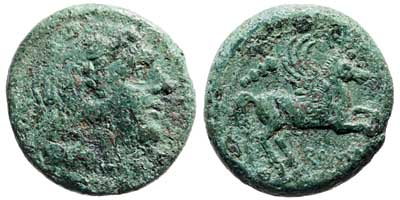 A bronze double litra from the early Roman Republic, 230-225 BCE. It is 19mm across and weighs 5.09 grammes.
A bronze double litra from the early Roman Republic, 230-225 BCE. It is 19mm across and weighs 5.09 grammes.
This next coin is from the early Roman Republic, and was made in the Greek style specifically for trading with the Greek towns to the south. On one side is Hercules wearing his lion-skin, and on the other, Pegasus. This coin looks quite handsome in the hand, but its shiny, low contrast surface made it extremely difficult to photograph effectively.
The design looks a lot more Greek than Roman, but the word ROMA under Pegasus is a clear indication of its origin.
Next, three silver coins of the Roman Republic, all issued by the moneyer Q. Titius in 90 BCE, all with different obverses, but all showing Pegasus on the reverse.
The first coin is a quinarius, worth half a denarius. On the obverse is a bust of winged Victory, and on the reverse, Pegasus is springing into the air.
The next two coins are denarii. The coin on the left has the head of Liber, wreathed with ivy (there is more about him on my page on Dionysos and Father Liber).
The other shows a deity called Mutinus Titinus, sometimes called Mutinus Mutunus, a Roman equivalent of the god Priapus. The reverse of both denarii shows Pegasus springing from what is normally described as a "tablet."Western Celts
Now a move to the far end of civilisation: two Celtic coins, in quite different styles.
On the left, a small bronze coin of Cricironus of the Suessiones tribe of Belgic Gaul, north of the Seine. The blank flan for this coin has been cast, and you can clearly see the sprues where a row of blanks were separated from each other. Then the image has been struck on it in the usual way.
The obverse has a very weak strike, which seems to be common for this type of coin. The reverse has a celticised version of Pegasos.
On the right, a coin from Celtic England. Cunobelin ruled the Trinovantes and the Catuvellauni, tribes which lived north of the Thames. Their main centres were Caer Colun, later Camulodunum to the Romans, now Colchester; and Verlamion, later Verulamium to the Romans, and now St Albans. This coin has Pegasus on its obverse, with CVNO for Cunobelin, and on the reverse is winged Victory sacrificing a bull, with TASCI for Cunobelin's father Tasciovanus. You can see from its style that there has been quite some Romanising influence here, and this predated Claudius's invasion.
 A Bronze tetrachalkous of Mithridates II from Parthia, 121-91 BCE. It is 18mm across and weighs 3.5 grammes.
A Bronze tetrachalkous of Mithridates II from Parthia, 121-91 BCE. It is 18mm across and weighs 3.5 grammes.
Parthia
Parthia was a powerful empire to the east of Rome, and it was during Mithridates II's reign that a Parthian ambassador met a Roman formally for the first time. The ambassador, Orozabes, was outmanoevred by the Roman Republican magistrate Sulla and for that failing, he was executed on his return to Parthia.
I am afraid I have not been able to find any explanation for the winged horse on this low demonination bronze coin. It's the only Pegasus type I have seen from Parthia, and it shows Pegasos leaping into the air, a type that must have been familiar on other coinage at the time.
The Roman Empire
Here is Pegasus in the heart of the Roman Empire. The usual descriptions say he is "stepping right," but you can see he isn't moving at all – just raising one foreleg – although this does vary a little from coin to coin. This pose is not often seen, but you can also find it on the coin of Tiberius from Corinth, near the top of this page.
Perhaps Pegasus is greeting Domitian, who was quite willing to link himself to Minerva (Athena), the goddess who produced the golden bridle that tamed Pegasus. But it is also possible that this depicts him in the act of creating the famous Hippocrene spring, which inspired the Muses, by striking the ground with one foot. (Thanks to Ben Lee Damsky for this suggestion.)
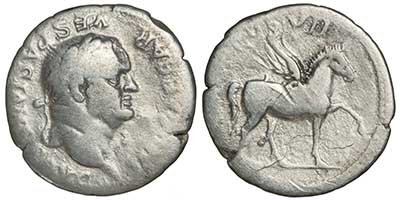 A silver denarius of Vespasian, from an Eastern mint, 76 CE. It is 19mm across and weighs 2.8 grammes.
A silver denarius of Vespasian, from an Eastern mint, 76 CE. It is 19mm across and weighs 2.8 grammes.
And here is the equivalent on a coin of Domitian's eldest brother, Vespasian. This coin is quite scarce and no-one knows exactly where in the east it was struck. But Pegasos is in exactly the same pose, foot raised, ready to strike down.
I saw one of these a few years ago on which I thought that Pegasus looked more like a carthorse, and on this coin also he is rather more stocky than on Domitian's coin from Rome.
Next, a Roman dupondius on which Pegasus leaping into the air, perhaps from a hillside. He has rather long spidery legs. This is the only Pegasus coin I have on which it is definitely clear that he is a stallion.
The last coin in this group is an antoninianus of the emperor Gallienus. It is one of a large series of coins he struck with animal themes, real or mythical. They are known to collectors as Gallienus' Zoo, and they entreat a variety of gods to preserve the Augustus (Gallienus). This one is to the sun-god Sol. Pegasus, much more stylised than on the Flavian or Hadrianic coins, is springing from a baseline, rather like the Hadrian and republican coins above.
 A bronze AE18 of Commodus from Hadrianopolis, 117-192 CE. It is 16 x 18mm across and weighs 2.65 grammes.
A bronze AE18 of Commodus from Hadrianopolis, 117-192 CE. It is 16 x 18mm across and weighs 2.65 grammes.
Roman Provinces
Roman provincial coins often had interesting reverses. This is a scarce bronze coin from from Hadrianopolis in Thrace, with a dark shiny patina that is typical of the region. This may be the best known specimen; it is certainly not widely documented. It has a lively Pegasus with a very expressive face.
The black shiny surface of this coin made it hard to get a good photograph, until I removed the wax which the seller had applied. Unfortunately, that revealed more of the scratching which had been caused by careless cleaning, but it is a more honest presentation.
 A bronze AE24 of Elagabalus from Hippos-Susita, 218-222 CE. It is 22 x 24mm across and weighs 14.39 grammes.
A bronze AE24 of Elagabalus from Hippos-Susita, 218-222 CE. It is 22 x 24mm across and weighs 14.39 grammes.
This coin is from a town in the Syrian Dekapolis which was called Susita by its Aramaic inhabitants, Hippos by early Greek immigrants, Antiochia ad Hippum by the Romans, and now Qal'at el-Husn by the Arabs; all meaning "horse," because the plateau on which it was built was shaped vaguely like a horse's head. (The Arabic actually means "Fortress of the Horse".) As a result, most of its coins had a horsey theme.
This is an unusual Pegasus, standing with his head turned back and both wings spread. His leg is forward, rather like the foot-striking position on the denarius of Domitian a few coins above, but in this case, the spread wings are the important feature. His tail is held high, and seems to be bound at the base, making him look like a domestic stallion rather than a wild creature.
Pegasus as a Symbol
 A bronze AE33 of Philip I from Samosata, 244-249 CE. It is 32 x 33mm across and weighs 19.82 grammes.
A bronze AE33 of Philip I from Samosata, 244-249 CE. It is 32 x 33mm across and weighs 19.82 grammes.
There are a number of coins on which Pegasus appears, not as the main subject, but as a control mark or a lesser symbol.
This large and well-made coin of the emperor Philip I, from a provincial city in Commagene, shows the city goddess, Tyche, seated on rocks, holding ears of corn and an eagle. Below her and to her left, Pegasus is flying.
 A silver drachm of Alexander III "The Great", 310-301 BCE. It is 18mm across and weighs 4.21 grammes.
A silver drachm of Alexander III "The Great", 310-301 BCE. It is 18mm across and weighs 4.21 grammes.
On the right, a silver drachm of the famous conqueror Alexander the Great. It has his trademark design, the head of the hero Hercules in a lion-skin headdress, with a seated Zeus on the reverse.
Alexander's drachms and tetradrachms used a range of monograms and control symbols during their time, and this one has the forepart (or protome) of Pegasus on the left of the reverse, just in front of Zeus' knee and below his eagle.
This next large bronze coin has a scene from the legend of snake-haired Medusa on the reverse, showing her death at the hands of the hero Perseus. He is holding his sword in one hand and her severed head in the other, and the curls below are the blood still flowing from Medusa's severed neck. This is a very bloodthirsty coin.
The obverse shows the head of the goddess Athena, who helped Perseus in his conquest of the monster. She is shown in the style of the colossal statue in the Parthenon, and like that statue, on her helmet is none other than Pegasus.
| The content of this page was last updated on 17 February 2013 |
| Home Page | Site Map | Useful Links | Email Me | Glossary | Next Page |
